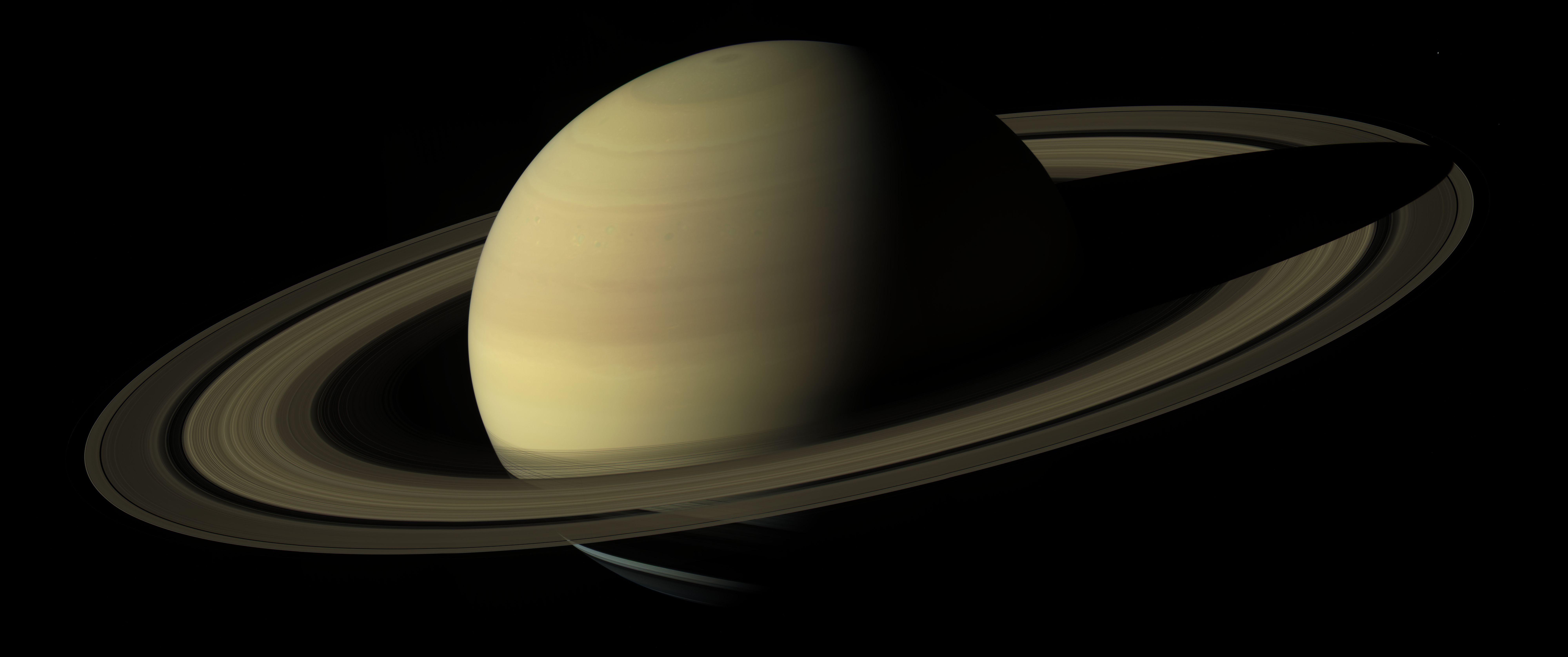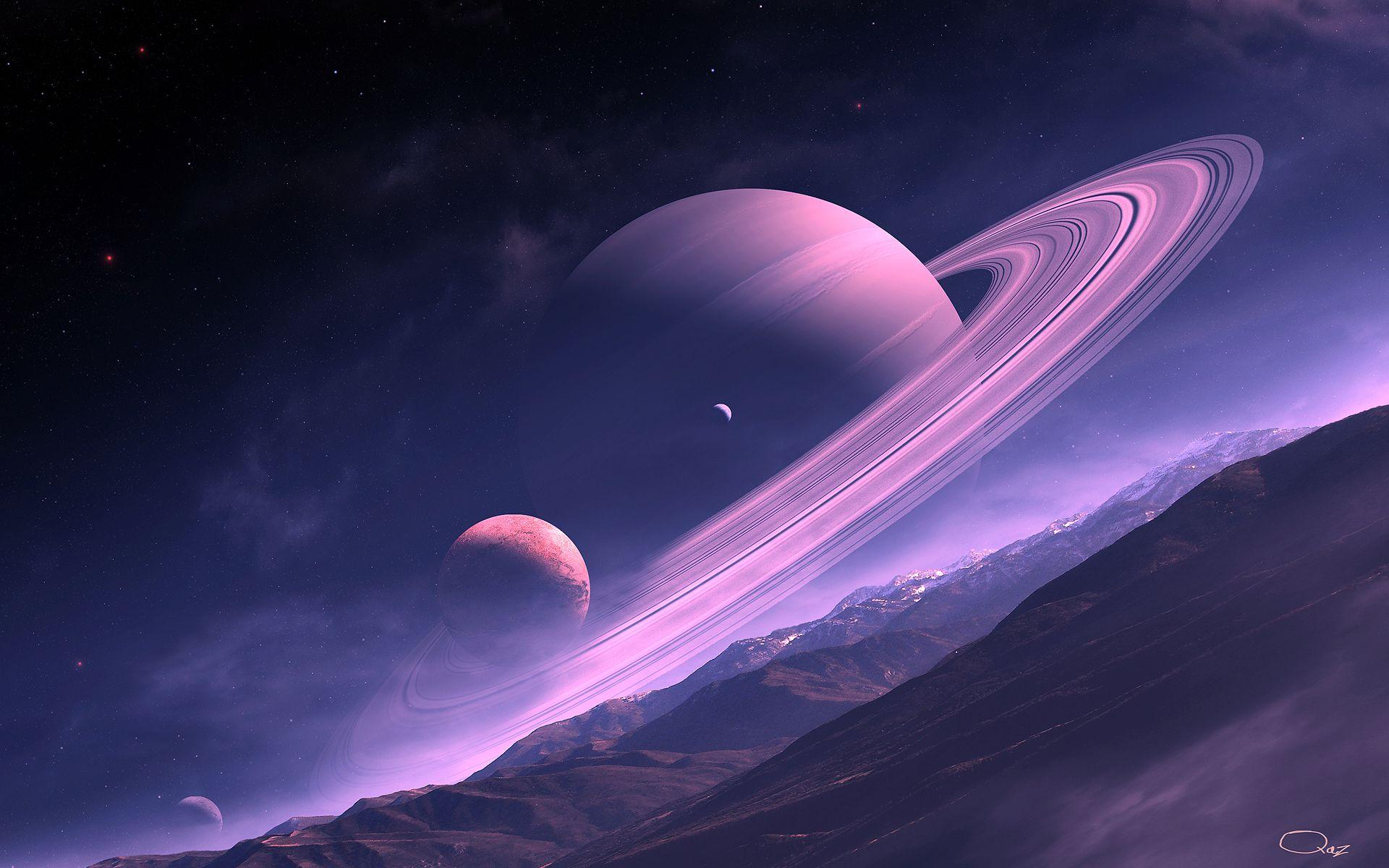Saturn’s Appearance: Saturn Wallpaper

Saturn, the sixth planet from the Sun, is renowned for its stunning appearance. Its most distinctive feature is its magnificent ring system, a mesmerizing collection of icy particles that encircles the planet. These rings are composed primarily of water ice, with traces of other substances such as dust and rock. They extend outward from Saturn’s equator for a distance of approximately 282,000 kilometers, creating an awe-inspiring spectacle.
Saturn itself is a gas giant, with a predominantly hydrogen and helium atmosphere. Its shape is not perfectly spherical but rather oblate, meaning it is slightly flattened at the poles and bulges at the equator. This shape is a result of the planet’s rapid rotation, which causes the equatorial regions to bulge outward. Saturn’s atmosphere exhibits a variety of cloud patterns, including banded zones and swirling vortices, which create a dynamic and ever-changing appearance. The planet’s color is predominantly pale yellow, with subtle hues of brown and gold.
Saturn’s Rings
Saturn’s ring system is one of the most iconic features in our solar system. It consists of countless icy particles, ranging in size from tiny dust grains to massive boulders. The rings are divided into several distinct divisions, each with its own unique characteristics. The most prominent division is the Cassini Division, a wide gap that separates the A and B rings. The A ring is the outermost and brightest of the main rings, while the B ring is slightly fainter and narrower.
In addition to the main rings, Saturn also has several smaller and fainter rings, including the C ring, the D ring, and the E ring. These rings are composed of smaller particles and are located farther from the planet. The E ring is particularly interesting as it is composed of water ice particles that are ejected from the geysers of Saturn’s moon, Enceladus.
Saturn’s Atmosphere, Saturn wallpaper
Saturn’s atmosphere is composed primarily of hydrogen and helium, with traces of other gases such as methane, ammonia, and water vapor. The atmosphere is divided into several layers, including the troposphere, stratosphere, and thermosphere. The troposphere is the lowest layer and is characterized by strong winds and convective activity. The stratosphere is the middle layer and is where the planet’s iconic cloud patterns form. The thermosphere is the outermost layer and is characterized by high temperatures and low density.
Saturn’s cloud patterns are highly dynamic and change constantly. They are composed of ammonia ice crystals and water vapor, and they exhibit a variety of colors, including white, yellow, and brown. The planet’s most prominent cloud feature is the Great White Spot, a massive storm that occurs approximately every 30 years. The Great White Spot is characterized by its bright white color and its large size, which can span thousands of kilometers.
Saturn’s Moons and Rings

Saturn is renowned for its majestic ring system and an impressive retinue of moons. Its most prominent moon, Titan, is the second largest in the Solar System, surpassing even Mercury in size. Enceladus, another captivating moon, harbors a vast subsurface ocean beneath its icy exterior. Rhea, with its distinctive grooved terrain, is a fascinating object of study.
Saturn’s Major Moons
Saturn boasts over 80 moons, each possessing unique characteristics. Among them, Titan stands out as the largest, shrouded in a dense, nitrogen-rich atmosphere. Its surface is adorned with methane lakes and hydrocarbon dunes, hinting at the possibility of prebiotic chemistry and extraterrestrial life.
Enceladus, despite its diminutive size, captivates scientists with its icy plumes erupting from its south polar region. These plumes spew water vapor and organic molecules into space, fueling the Saturnian magnetosphere and providing tantalizing clues about the potential for life beneath its icy shell.
Rhea, with its intricate network of grooves and ridges, presents a mesmerizing spectacle. These enigmatic markings are believed to have formed through tectonic processes, offering insights into the moon’s geological evolution.
Saturn’s Ring System
Saturn’s iconic ring system, composed primarily of water ice particles, is a captivating celestial spectacle. Spanning hundreds of thousands of kilometers, the rings are divided into several distinct divisions, each with its own unique characteristics.
The formation of the rings remains an intriguing mystery, with theories ranging from the remnants of a shattered moon to the accretion of icy material from the solar nebula. Regardless of their origin, the rings are a testament to the dynamic processes that have shaped Saturn’s celestial neighborhood.
The interactions between Saturn’s moons and rings are complex and intricate. The moons act as shepherds, influencing the shape and structure of the rings through their gravitational pull. In turn, the rings exert gravitational forces on the moons, affecting their orbits and orientations. This delicate dance between moons and rings contributes to the mesmerizing beauty and scientific significance of the Saturnian system.
Exploration and Discovery

Saturn wallpaper – Saturn has been a captivating target for space exploration, revealing fascinating insights into its enigmatic system.
Missions and Discoveries
The Cassini-Huygens mission, a joint endeavor by NASA, ESA, and the Italian Space Agency, stands as a monumental achievement in Saturnian exploration. Launched in 1997, Cassini orbited Saturn for 13 years, capturing breathtaking images and gathering invaluable data.
Cassini’s Huygens probe made a historic descent onto Titan, Saturn’s largest moon, in 2005. The probe transmitted stunning images of Titan’s surface, revealing a complex and Earth-like environment with rivers, lakes, and dunes.
Cassini’s discoveries transformed our understanding of Saturn and its system. It revealed the intricate structure of Saturn’s rings, identified new moons, and provided detailed insights into the planet’s atmosphere and magnetosphere.
Future Exploration
The legacy of Cassini-Huygens continues to inspire future exploration. NASA’s Dragonfly mission, scheduled for launch in 2027, will send a rotorcraft to explore Titan’s surface, studying its chemistry and habitability.
Other proposed missions, such as the Saturn Atmospheric Entry Probe (SAEP), aim to further unravel Saturn’s atmospheric dynamics and composition. These missions hold the potential to unlock even more secrets of this captivating planet and its enigmatic system.
Eh, bosen nih sama wallpaper Saturn di hape gue. Pengen cari yang lebih kece, tapi bingung mau ganti apa. Eh, ngomong-ngomong soal wallpaper, tau gak sih kalau sekarang lagi ngetren live wallpaper android ? Keren banget, gambarnya bergerak-gerak gitu. Tapi kalau gue sih tetep suka sama wallpaper Saturn, soalnya adem liatnya.
Nah, kalau ngomongin wallpaper yang keren, bukan cuma wallpaper saturn aja yang kece. Ada juga wallpaper heart wallpaper yang nggak kalah kece. Gambar hati-hati yang lucu dan warna-warni bisa bikin suasana kamar jadi lebih ceria. Tapi balik lagi ke wallpaper saturn, planet bercincin ini memang punya pesona tersendiri.
Wallpaper saturn yang bagus bisa bikin kamar jadi keliatan lebih luas dan elegan.